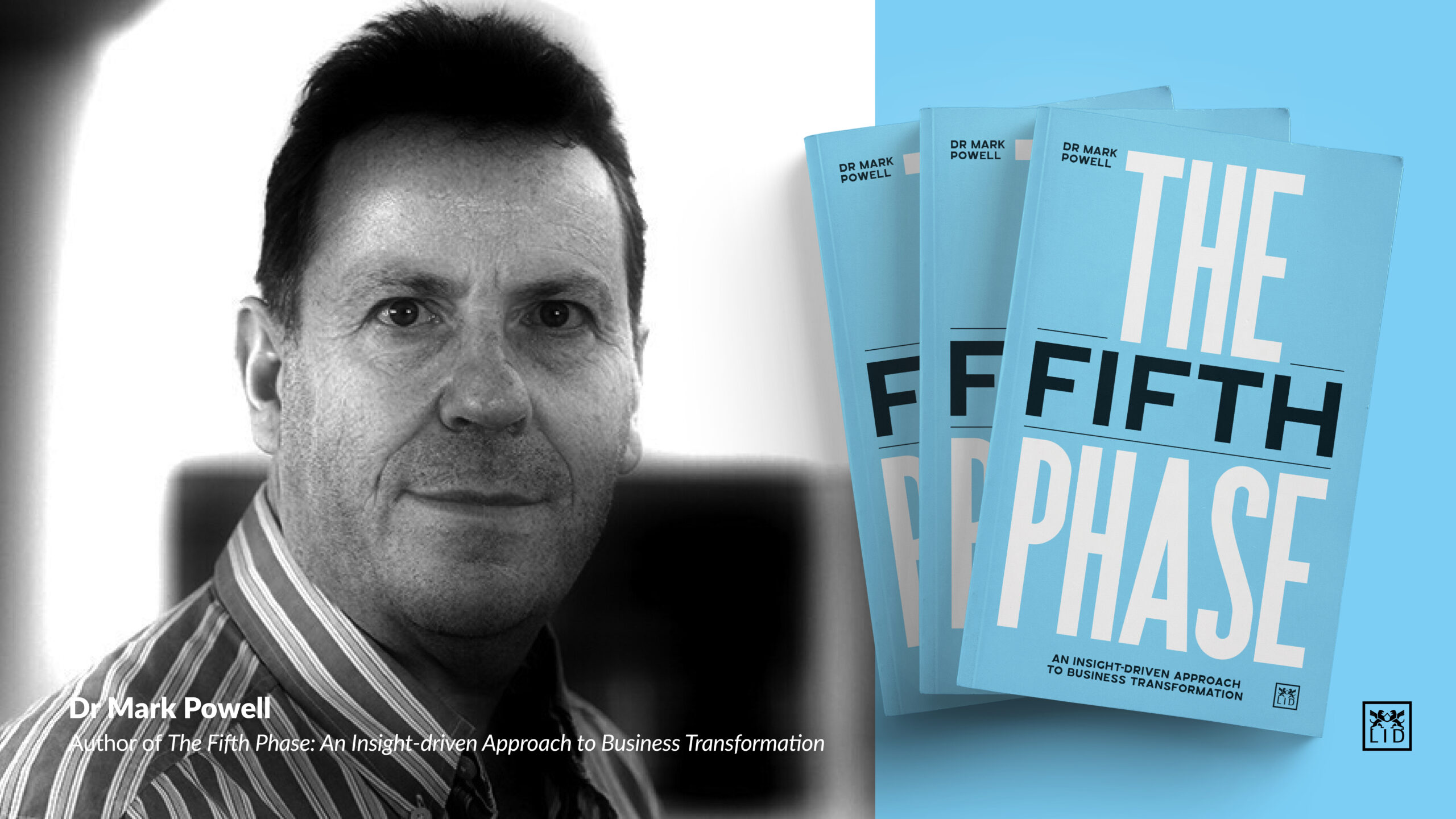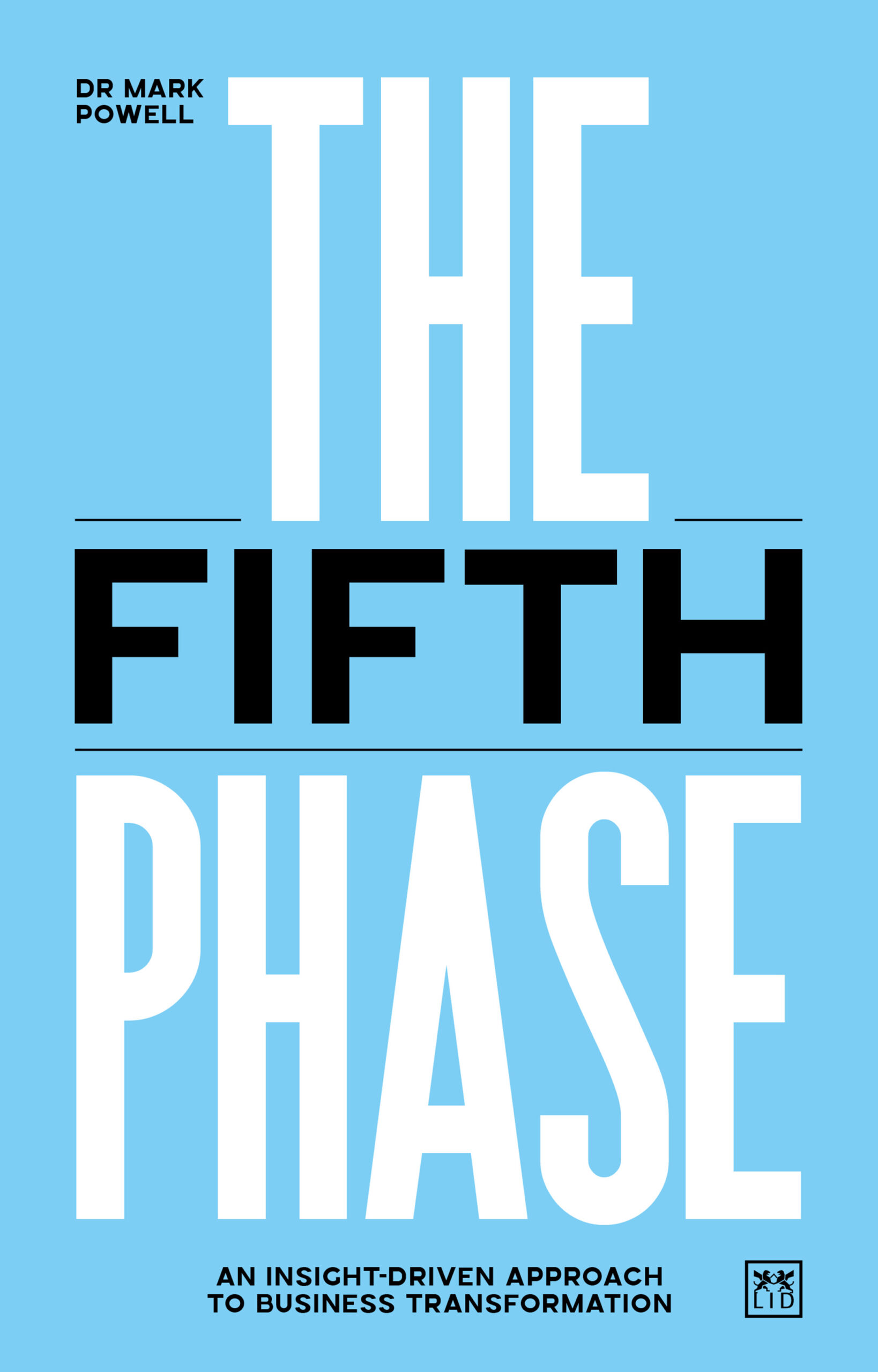|
Moving from ‘Data Up’ to ‘Value Down’ with Mark Powell
Moving from ‘Data Up’ to ‘Value Down’

By Guest Contributor Dr Mark Powell
Author of The Fifth Phase, Dr Mark Powell, shares why businesses will benefit if they move from ‘data up’ to ‘value down’.
In an earlier article, I offered a quick introduction to the concept of a fifth phase of business transformation as described in my recent book, The Fifth Phase: An Insight-driven Approach to Business Transformation. I have been a business and strategy consultant for over 30 years, and in recent years I have seen the beginnings of what I am certain will be a revolution in business transformation: the move from the current conviction that creating huge data lakes will somehow magically create valuable business insights to a more scientific approach that tests small amounts of data to see if they have the capability to deliver valuable insights before investing in acquiring and cleaning that data. We need to move from a data-driven, ‘data up’ approach to a value-driven, ‘value down’ approach.
The first three phases of business transformation began in the late nineteenth century with Scientific Management – the original ‘time and motion study’ – and developed through Enterprise Resource Planning to process management systems such as Lean Six Sigma. The fourth phase was based on the mistaken belief that ‘data is the new oil’, which led to what I have argued was a highly unproductive phase during which a great deal of time and money was spent on building and maintaining vast data lakes, with little obvious benefit to business.
I spend a surprising amount of my time disappointing clients by telling them that their data, in itself, has no value. But a set of data that has no apparent inherent value may have the potential to become extremely valuable when linked to other sets of data and viewed through the lens of value.
Business leaders’ key task is to help frame the vital questions that, if answered, have the potential to add real value to their businesses. I find it useful to see any business as a series of potential optimisation points, and then work out which individual optimisation has the capacity to deliver the most added value across the whole business. The goal is to produce a ‘value map’ of the organisation. Very often, the optimisation points that have the most value occur throughout the various silos of the organisation. Making a radical improvement to these optimisation points has the potential to ripple through the whole organisation, adding surprising amounts of new value. The trick is to ‘test’ this optimisation to create a ‘proof of value.’
Proof of value
The concept of proof of value is distinct from the usual understanding of ‘proof of concept’ in business. Very few proofs of concept break genuinely new ground. They tend to apply established techniques to a business problem to achieve a desired, known outcome. The focus tends to be more on whether the solution will actually work than on whether it will deliver real value. With proof of value, the focus is on testing small-scale but valid scenarios to see if they not only work but also deliver real value – and potentially outstanding real value. Embarrassingly large numbers of data projects have consumed huge amounts of money and failed to deliver any significant value. Sometimes they failed to work at all and were abandoned. As referenced in my earlier article, a Gartner analyst estimated in 2017 that 85% of big data projects fail.
Proof of value is an experimental, agile process. Sometimes, the type of data you need for analysis is already being captured by your business, but not in a form that will solve the problem you have. My team and I once did some work for a major soft drinks manufacturer, looking at one of their bottling plants. The facility was experiencing frequent breakdowns and delays and operating well below theoretical capacity.
The bottling line was controlled by programmable logic controllers (PLCs). These devices have little in the way of onboard memory and are not typically networked, but they do have a component known as an ‘historian.’ This records a history of machine errors for up to seven days, when the available memory is full and the error history is recorded over with new data.
In theory, this record of errors – including the timing, type and frequency of error – is the sort of data that should provide us with the raw information needed to work out the cause (or causes) of the factory line’s problems. But because the data was being deleted weekly, there wasn’t enough to allow an effective analysis of the error history. One week’s data would capture perhaps one significant failure, but it wouldn’t allow a deeper analysis to reveal the subtle combination of events that were leading to frequent breakdowns over time. The PLCs were upgraded to be able to collect several months of data, and we used machine-learning techniques to reveal the pattern of issues behind what turned out to be a complex chain of events: the answer turned out to be something very non-obvious, as in ‘if this, and this, and this, then that, but only if…’ The plant was collecting the right data; there just wasn’t enough of it. And we needed the power of AI to reveal the highly complex patterns buried in the data.
It is hard — perhaps impossible — to know in advance exactly what data will give us the insight we need to solve our future problems. The answer is not to collect and hoard every imaginable piece of data in the hope that it holds the answer we need. The answer is to identify the insights we need and then test data from all available sources, to see if they have the potential to deliver.
Leaving the ‘tool-o-sphere’
Business transformation is not a technical issue, it’s a business issue. This will require leaders to think and act differently about data. Rather than seeing data as operational, we need to see it as an enabler for real business transformation. We need to constantly articulate big, valuable questions and identify the insights that have the potential to drive value – and then we need to interrogate small samples of various datasets to see if they have the potential to deliver the answer.
The biggest challenge to achieving genuinely transformational results is that many businesses struggle to support changes that go beyond the sphere of normal business. It is much easier to improve an existing business practice (as in the third phase of business transformation, process management) than it is to consider running that business in a radically different way.
Data analytics has the capacity to deliver the insights we need to transform our businesses. But most data currently live in what I am going to call the ‘tool-o-sphere’ — a world in which the goal is the development of a better dashboard to monitor existing processes and look for relatively minor efficiencies. We are fretting (understandably) about improvements of a fraction of a decimal point, when we may be missing opportunities that would literally transform our business and our bottom line.
An unfortunate divide has grown up between the world of data and the executives making the key decisions that will shape a business’s future. It is entirely fair for people to point to the hugely significant role their Chief Data Officer has in their organisation, but in my experience, most IT departments see their job as providing tech and tools for the businesses they serve. There is a worrying disconnect between the people who understand the technology and those who are running the business side. People in the tech sphere come to believe that their job is to provide tools that the organisation can use. People on the business side don’t understand the full potential of the technology and continue to pursue what are essentially process management solutions, when the technology has the potential to transform the business — but only if it is asked to deliver the relevant insights.
It’s time to get the data scientists working alongside their colleagues on the key business issues faced by the organisation so they can begin to think about possible data solutions. Otherwise, they will stay trapped in the tool-o-sphere, providing the business with tools that are delivering a tiny fraction of the full potential value hidden somewhere in some vital piece of overlooked data that no one is currently interrogating.
ABOUT THE AUTHOR
Suggested Reading
 Big data has new and exciting answers to offer, but business leaders must first decide what questions it would like to see answered. Data may be the new oil, but to date we have only built oil depots. This book analyses the new, Fifth Phase of business transformation, which will build the refineries that turn data into useful products. Business has started from ‘data up’ and needs to start again from ‘value down’, going back to the drivers of real business value and deciding what insights would help realize that value. Only then can we begin to interrogate data with purpose.
Big data has new and exciting answers to offer, but business leaders must first decide what questions it would like to see answered. Data may be the new oil, but to date we have only built oil depots. This book analyses the new, Fifth Phase of business transformation, which will build the refineries that turn data into useful products. Business has started from ‘data up’ and needs to start again from ‘value down’, going back to the drivers of real business value and deciding what insights would help realize that value. Only then can we begin to interrogate data with purpose.

